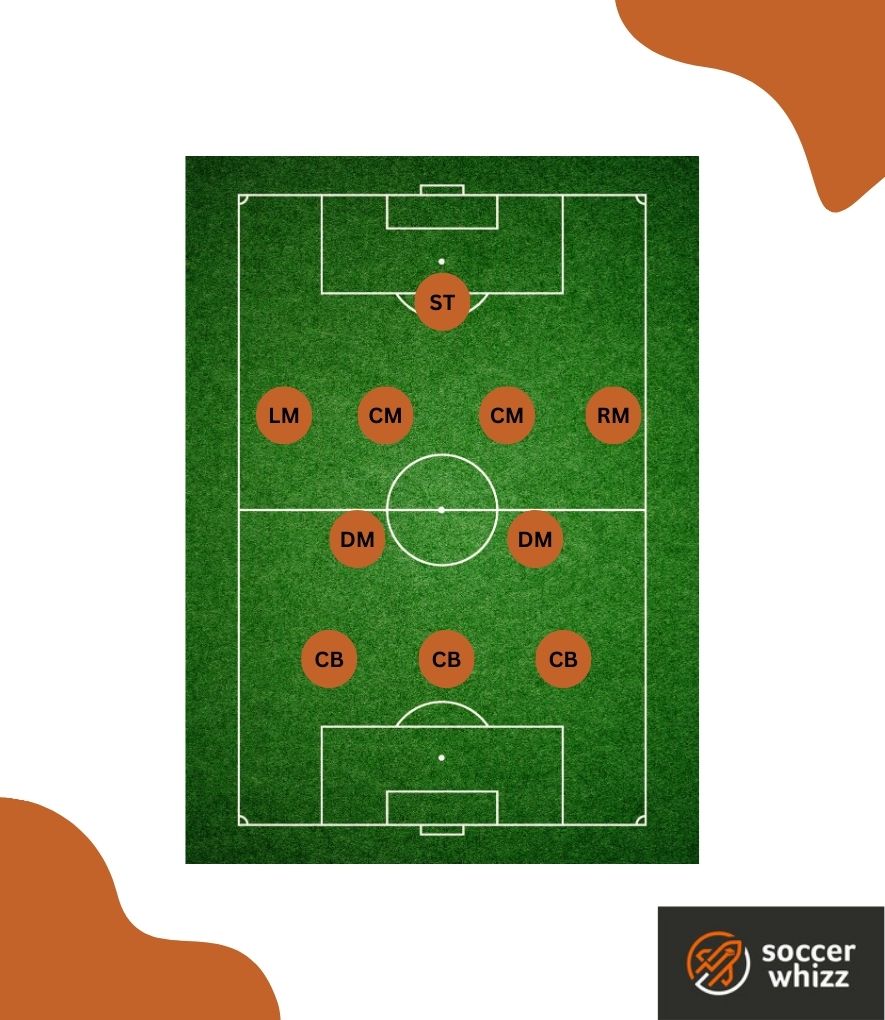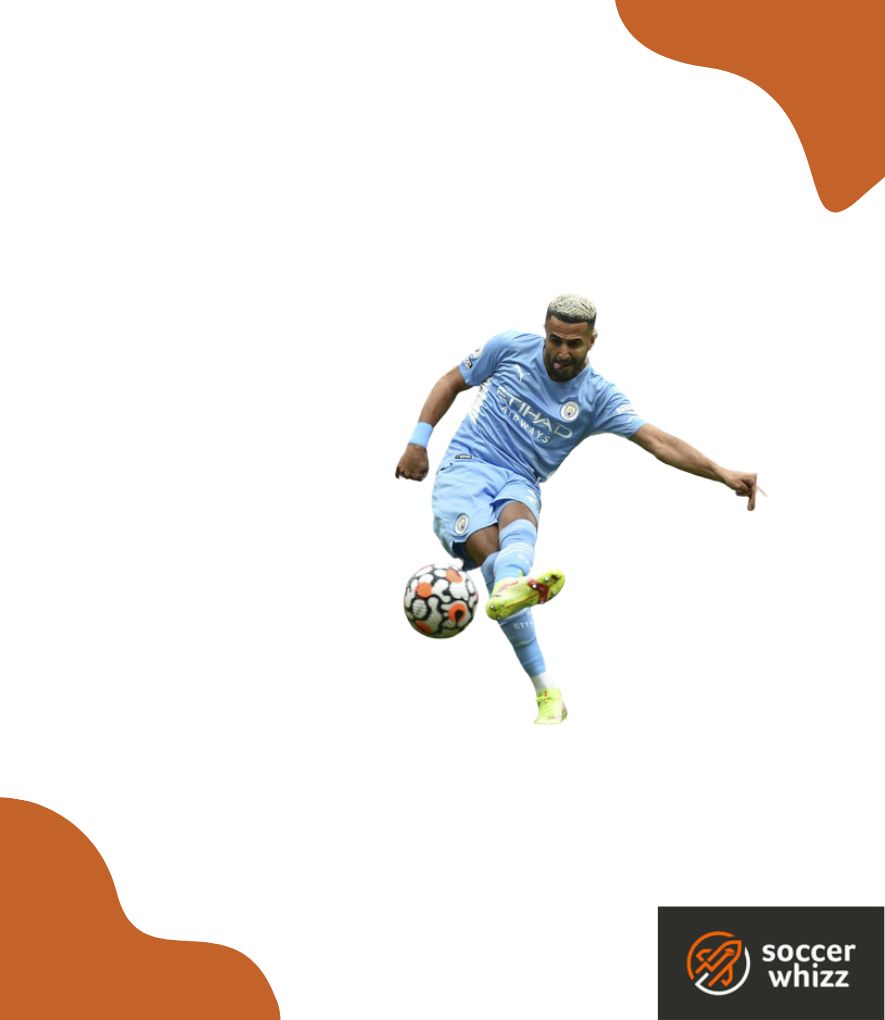Soccer is a sport that thrives on tactical innovation, where managers constantly seek new formations and strategies to gain a competitive edge.
In this ever-evolving world, the 3-2-4-1 soccer formation has emerged as a fascinating tactical puzzle.
As we delve into the intricacies of this 3-2-4-1 formation, we will explore its tactical nuances, the roles and responsibilities of each position, and how it enables teams to exploit the strengths of their players while posing unique challenges to opponents.
We will examine notable teams and managers who have successfully utilized this formation to revolutionize their playing style and achieve remarkable success on the field.
How does a 3-2-4-1 formation work?
Known as the “christmas tree” formation, the 3-2-4-1 formation showcases three central defenders, a midfield double pivot, four attacking midfielders, and a lone striker.

This tactical setup facilitates seamless mobility, adaptability, and efficient ball distribution.
In the 3-2-4-1 formation, the wing-backs play a crucial role in both defense and attack.
They provide width to the team’s play by overlapping the midfield and providing additional options on the flanks.
This stretching of the opposition’s defense creates spaces for the attacking midfielders to exploit.
The formation also allows for positional fluidity, giving players the freedom to adjust their positions based on the flow of the game.
This flexibility enables the team to adapt to different match scenarios, exploit opponent weaknesses, and create unpredictability in their attacking movements.
Why did Pep Guardiola decide to employ this 3-2-4-1 shape?
By adopting the 3-2-4-1 formation, Pep Guardiola made a brilliant move to strengthen Manchester City’s defensive capabilities.
The inclusion of an extra central defender significantly enhanced their defensive solidity, offering improved coverage and reducing vulnerability to counter-attacks.
When faced with the challenge of containing formidable wingers like Mohammed Salah, Guardiola recognized that deploying a centre-back such as Manuel Akanji or Nathan Aké in a one-on-one battle was more effective than relying on an attacking full-back like Cancelo.

One of Guardiola’s masterstrokes was employing John Stones as one of the midfield pivots.
This decision not only provided defensive stability but also capitalized on Stones’ remarkable footballing ability, enabling him to control the midfield in the box-to-box role.

City’s success was built upon this defensive foundation, as they conceded fewer goals and maintained a firm grip on matches, frustrating opponents and limiting their scoring opportunities.
The double pivot in midfield, formed by two central midfielders in the 3-2-4-1 formation, offered a robust platform for dictating the game’s flow.
Both Rodri and Stones excelled in their defensive duties while showcasing creativity and adept ball control.
Benefiting from a numerical advantage in the box-midfield area, Manchester City excelled in setting the tempo, dominating possession, and launching precise attacks.
The midfield duo demonstrated exceptional positional awareness, disciplined defensive work, and efficient distribution of the ball.
This control allowed City’s creative attacking midfielders to exploit spaces, generate scoring chances, and display their vision, technical skills, and playmaking abilities.
Guardiola’s decision to utilize four attacking midfielders within the 3-2-4-1 formation offered Manchester City an abundance of versatile and interchangeable options in the final third.
Unconventional wide players like Jack Grealish or Bernardo Silva were given the freedom to cut inside, combine with the central attacking midfielder, or make diagonal runs, creating confusion among opposing defenses.

This fluidity and adaptability of positions led to a plethora of attacking combinations, rendering City’s forward line unpredictable and incredibly challenging to defend against.
What are the benefits of this 3-2-4-1 system?
The 3-2-4-1 formation offers several benefits that contribute to a team’s performance on the soccer field:
1. Defensive solidity
With three central defenders and a double pivot in midfield, the 3-2-4-1 formation provides a solid defensive structure.
The additional central defender increases coverage and improves man-marking, making it difficult for opponents to break through the defensive line.
This reduces the vulnerability to counter-attacks and strengthens the team’s overall defensive stability.
2. Flexibility and fluidity
The formation allows for positional fluidity and versatility among players.
The attacking midfielders can interchange positions, creating confusion for opposing defenders and opening up spaces for scoring opportunities.
This fluidity enhances the team’s attacking prowess and makes it harder for opponents to predict their movements.
3. Control of midfield
The double pivot in midfield, formed by two central midfielders, offers a strong platform for controlling the flow of the game.
Here’s a video which offers insight into this on-field advantage brought about by the tactical setup:
This central midfield dominance enables the team to dictate the tempo, maintain possession, and launch precise attacks.
It also provides a solid foundation for both defensive and offensive transitions.
4. Numerical advantage
The 3-2-4-1 formation often provides a numerical advantage in the box-midfield area.
This allows the team to overload the midfield, outnumber opponents, and create passing triangles, which facilitates effective ball circulation and creates opportunities for intricate combination plays.
5. Attacking options
With four attacking midfielders and a lone striker, the 3-2-4-1 formation offers a multitude of versatile and interchangeable options in the final third.
The attacking midfielders can exploit spaces, showcase their creativity, vision, and playmaking abilities, while the lone striker serves as the focal point for goal-scoring opportunities.
6. Unpredictability
The fluidity and interchangeability of positions in the 3-2-4-1 formation make the team unpredictable and difficult to defend against.

Non-traditional wide players cutting inside, midfielders making runs, and overlapping wing-backs provide a variety of attacking combinations, making it challenging for opponents to anticipate and counter their moves effectively.
Are there any drawbacks to this shape?
While the 3-2-4-1 formation offers numerous advantages, it also presents certain drawbacks that teams should consider:
1. Vulnerability to wide attacks
With only two central midfielders and three central defenders, the formation can be susceptible to attacks from the wings.
The limited number of players in wide areas may struggle to cope with overlapping full-backs or wingers, potentially exposing the defensive line and creating gaps for opponents to exploit.
2. Lack of width
The 3-2-4-1 formation relies heavily on the overlapping runs of wing-backs to provide width in the attacking phase.
However, if the wing-backs are unable to contribute effectively to the width, the team may become too narrow, making it easier for opponents to defend and congest the central areas.
3. Defensive transition
Due to the advanced positioning of the attacking midfielders, the transition from attack to defense can be challenging.
If the team loses possession, quickly regaining defensive shape and preventing counter-attacks can pose difficulties, especially if the attacking midfielders are caught out of position.
4. Overemphasis on central play
While the formation excels in central midfield dominance, it may sometimes result in an over-reliance on play through the middle.
This predictability can allow opponents to congest the central areas, making it harder for the team to create scoring opportunities and encouraging them to explore wider options.
5. Lack of natural width players
The 3-2-4-1 formation often requires players to adapt to unconventional roles.
Non-traditional wide players may be deployed in the attacking midfield positions, which can limit natural wide play and crossing opportunities.
This can be a disadvantage when facing deep-lying defenses that are difficult to break down centrally.
6. Limited striker support
The lone striker upfront may occasionally lack support in the attacking phase.
With the focus on the attacking midfielders, the striker may find it challenging to receive adequate service and may face difficulties in holding up the ball or creating scoring opportunities on their own.
Can the 3-2-4-1 be exploited?
Like any formation, the 3-2-4-1 can be exploited by astute opponents who identify and capitalize on its vulnerabilities.
Here are some potential ways in which the formation can be exploited:
Overloading wide areas
Opponents can target the wide areas by utilizing overlapping full-backs or wide midfielders to create numerical superiority against the wing-backs.
This can stretch the defensive line, isolate the wing-backs, and create opportunities for crosses or diagonal passes into the box.
Quick counter attacks
Given the advanced positions of the attacking midfielders, the 3-2-4-1 formation can be vulnerable to fast and direct counter-attacks.
If the team loses possession in advanced areas, opponents can exploit the spaces left behind and launch swift counter-attacks before the defensive structure is fully organized.
Pressing the double pivot
The two central midfielders in the double pivot can be targeted by aggressive pressing from the opposition.
By applying pressure on these players, opponents can disrupt the team’s build-up play, force turnovers, and limit their ability to control the midfield.
Exploiting the defensive transition
As the attacking midfielders push forward to support the lone striker, there may be gaps left in the midfield and defensive areas during defensive transitions.
Opponents can exploit these gaps by quickly transitioning from defense to attack, bypassing the midfield, and exploiting the spaces left behind.
Wide overloads and crosses
If the wing-backs are caught upfield during attacking phases, opponents can exploit the spaces they vacate.
By creating wide overloads and delivering accurate crosses into the box, opponents can challenge the three central defenders and capitalize on any defensive disorganization.
Cutting off central passing lanes
Opponents can aim to congest the central areas and cut off passing lanes, limiting the effectiveness of the attacking midfielders.
By denying space and forcing the team to play wide or attempt riskier passes, opponents can disrupt the flow of the team’s attacking play.
Concluding thoughts
The 3-2-4-1 formation stands as a fascinating and dynamic tactical system in the realm of soccer.
Its unique structure, combining defensive solidity with fluid attacking movement, offers teams a potent tool to dominate possession, control the midfield, and create scoring opportunities.
Throughout this article, we have explored the intricacies of the formation, delving into its tactical nuances, player roles, and the benefits it provides on the field.
In the ever-evolving world of soccer tactics, the 3-2-4-1 formation continues to captivate the minds of coaches, players, and fans.
Its successful implementation requires a deep understanding of its intricacies, astute player positioning, and effective communication on the field.
By harnessing the formation’s strengths and addressing its limitations, teams can unlock its full potential and achieve success in the beautiful game.
Should you wish to learn more about soccer formations, you can have a read of the following articles:
If you enjoy the content that I create and would like to buy me a coffee, then I’d really appreciate it!
Any money that I earn through this donation will be re-invested into more content for this website.
Additionally, by sending in a donation you’ll also receive a copy of my recently released 190+ page eBook on Soccer Ball Care, as well as be subscribed to our mailing list where you’ll be regularly informed on the latest developments concerning the Soccer Whizz blog.
- Future Icons: Europe’s Emerging Midfield Maestros Set for Glory - December 4, 2023
- Kickstarting a Revolution: How Soccer Transformed the United States Over the Last Four Years - October 7, 2023
- 4-1-4-1 Soccer Formation [Analysis] - September 23, 2023

